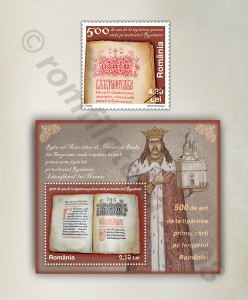 2008 marks the anniversary of 500 years from the printing of Macarie’s Liturghier (Macarie’s Missal), occasion on which Romfilatelia will release the postage stamp issue „500 years since the printing of the first book on the territory of Romania“. 2008 marks the anniversary of 500 years from the printing of Macarie’s Liturghier (Macarie’s Missal), occasion on which Romfilatelia will release the postage stamp issue „500 years since the printing of the first book on the territory of Romania“.
2008 marks the anniversary of 500 years from the printing of Macarie’s Liturghier (Macarie’s Missal), occasion on which Romfilatelia will release the postage stamp issue „500 years since the printing of the first book on the territory of Romania“. 2008 marks the anniversary of 500 years from the printing of Macarie’s Liturghier (Macarie’s Missal), occasion on which Romfilatelia will release the postage stamp issue „500 years since the printing of the first book on the territory of Romania“.
The development of the writing and printing techniques on the territory of Romania starts with the first writing form „pictographic alphabet“, very similar to the world’s ancient writing system, the Sumerian one, and continues with the burnt clay plates. This type of support, same as clay pots, tree bark or the parchment were extensively used prior to discovering the paper, moment that marked the emersion of the first paper mills.
The 16th century stands out grace to the printing of the most important manuscripts and printings in Romania.
Worthy of all attention, exceptional manuscripts include the first Romanian written text that we still have, namely „THE LETTER WRITTEN BY NEACSU IN CAMPULUNG“, in 1521, a letter addressed to Hans Benkner the Judge of Brasov, as well as the one written in Slavonic „NEAGOE BASARAB’S TEACHINGS TO HIS SON TEODOSIE“.
The first book that saw the printing press on the territory of our country is „MISSAL“ printed in 1508 by Hieromonk Macarie.
The history of the beginning of the 16th century in Wallachia is marked by the reign of Radu cel Mare (Radu the Great) (1495-1508), wise, king, and just ruler.
Having been granted an illustrious education as any royalty at the time, Radu cel Mare, was the one to have linked his name to the printing of the first manuscript on the territory of Romania.
In order to consolidate the reputation of the Church as a main supporter of the state, the ruler brought monk Macarie, Serbian hieromonk in Montenegro, trained as a printing worker in Venice (where manuscripts in Slavonic were printed, who had already printed 5 books (in Cetinje between 1493 and 1495). In the royal printing house at Dealu Monastery lead by Macarie the first three books were printed: „LITURGHIER“/„MISSAL“ (1508), „OCTOIH“/„HYMN“ (1510), and „EVANGHELIAR“/„GOSPEL-BOOK“ (1512), all of them written in Slavonic, language at the time
exclusively used in royal clerical halls and in religious services as the official language.
Romania currently has 5 copies of Macarie’s „LITURGHIER“/„MISSAL“: three of the copies are preserved by the Romanian Academy Library – the rare manuscripts section – (the unique copy and its doublet being welded in leather and wood) – one is hosted by the Orthodox Archbishopric Library in Sibiu and another one by the Central State Library in Bucharest. Another copy is hosted abroad in Belgrade, at Narodna Biblioteka Srbije.
The Missal of 1508 has 128 leafs (256 pages), is numbered on notebooks, comprises 6 frontispieces (in 3 variants),
initial letters are adorned and each page has 15 rows with text in black and red.
As all Slavonic missals, manuscripts printed in Wallachia and Moldavia during the 16th and the 17th centuries, Macarie’s Missal comprises all the three orthodox liturgies: Ioan Gurã de Aur, Vasile cel Mare, and the „afore-hallowed“, preceded by the typical liturgy, including the „deacon’s service“. Macarie’s Missal however starts with the lecture of Vasile cel Mare to the priests, the text of the manuscript having the editor’s epilogue on the last page, which, according to the habits of the time, was a foreword to the manuscript while some of the prayers added at the end were extremely rare.
The postage stamp of the issue with a face value of RON 4.30 represents the image of a page in the Missal, fully adorned with red text.
The postage stamp of the philatelic souvenir sheet with a face value of RON 9.10 reproduce two pages of the Missal, fully adorned with black and red text and the margin of the souvenir sheet shows the image of ruler Radu cel Mare, the founding father of the Dealu Monastery in Targoviste where the manuscript saw the daylight.
We hereby express our appreciation for the Board of the Metropolitan Library from Bucharest for its support granted for the release of the postage stamp issue.
Issue date: 2008-06-25



